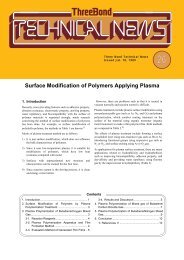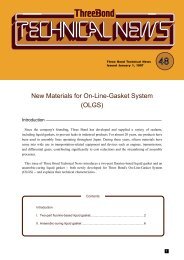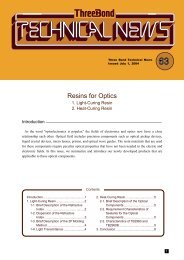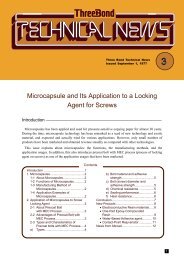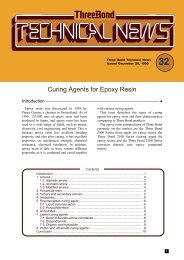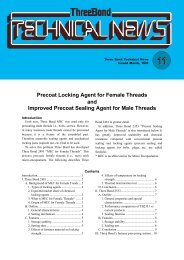Pressure resistance mechanism of reaction-type liquid gaskets (Part 2)
Pressure resistance mechanism of reaction-type liquid gaskets (Part 2)
Pressure resistance mechanism of reaction-type liquid gaskets (Part 2)
Create successful ePaper yourself
Turn your PDF publications into a flip-book with our unique Google optimized e-Paper software.
7. Precautions for joint section design<br />
The design <strong>of</strong> a flange system must take into<br />
account the interrelationships between operating<br />
conditions and physical properties <strong>of</strong> the <strong>liquid</strong><br />
gasket, the total tightening force <strong>of</strong> the bolts, flange<br />
shape, and external factors. (See Figure 31.)<br />
7-1. Difference from solid <strong>gaskets</strong><br />
1) Bolt tightening force and external factors<br />
The bolt tightening force determines the initial<br />
thickness <strong>of</strong> the gasket and affects the extent <strong>of</strong><br />
change in the joint section space in relation to<br />
external factors. Since the <strong>liquid</strong> gasket layer<br />
elastically follows changes in the joint section space,<br />
the large initial surface pressure required in the case<br />
<strong>of</strong> solid <strong>gaskets</strong> is not necessary.<br />
To identify the appropriate diameter, number, and<br />
initial tightening force <strong>of</strong> bolts, it is sufficient to<br />
consider the force required to hold the component<br />
so long as the displacement <strong>of</strong> both flange faces<br />
does not cause deformation exceeding the elastic<br />
limit <strong>of</strong> the gasket material.<br />
Table 9 shows the results obtained from a test <strong>of</strong> a<br />
flange system using <strong>reaction</strong>-<strong>type</strong> <strong>liquid</strong> <strong>gaskets</strong> in<br />
which bolts are removed when measuring the<br />
leakage pressure.<br />
Table 9. Leakage pressure <strong>of</strong> a flange measured<br />
without fixing bolts (kg/cm 2 )<br />
Type <strong>of</strong> gasket TB 1215<br />
Low-modulus<strong>type</strong><br />
silicone<br />
Anaerobic<br />
flexible <strong>type</strong><br />
Surface pressure at<br />
coating: 50 kg/cm 2 3.0 0.2 11<br />
Surface pressure at<br />
coating: 20 kg/cm 2 3.0 0.3 16<br />
Clearance: 100 µ 3.0 0.3 16<br />
2) Extent <strong>of</strong> joint surface finishing<br />
Solid <strong>gaskets</strong> require meticulous attention to the<br />
finish <strong>of</strong> joint surfaces.<br />
Spiral finishing marks and parallel streaks<br />
resulting from shaping or planing impair the<br />
performance <strong>of</strong> metal <strong>gaskets</strong>. Table 10 shows the<br />
extent <strong>of</strong> finishing required for solid <strong>gaskets</strong>.<br />
Table 10. Extent <strong>of</strong> finishing required for flange<br />
joint surface (solid <strong>gaskets</strong>)<br />
Gasket material<br />
Extent <strong>of</strong> finishing (S)<br />
Leather gasket 50 - 100<br />
Paper gasket 50 - 100<br />
Rubber gasket 50 - 100<br />
Compressed asbestos sheet 25<br />
Semi-metallic gasket 6.4 - 35<br />
Metal gasket 3.2 - 6.4<br />
Liquid <strong>gaskets</strong> require no such consideration due<br />
to their conforming ability. The only factors that<br />
need to be considered are those that affect the<br />
adhesiveness <strong>of</strong> the joint surface, such as oil stains.<br />
If the <strong>liquid</strong> gasket has adhesive strength<br />
corresponding to the elasticity <strong>of</strong> the material, it is<br />
possible to use a flange face that has not been<br />
machine-finished.<br />
3) Flange surface width<br />
Although the minimum width required for solid<br />
<strong>gaskets</strong> depends on the gasket thickness and<br />
material, solid <strong>gaskets</strong> are generally said to be a<br />
minimum <strong>of</strong> 5 mm. In the case <strong>of</strong> <strong>liquid</strong> <strong>gaskets</strong>, the<br />
length <strong>of</strong> the gasket (flange width) is adequate if it<br />
is greater than the distance available to relieve the<br />
compressive force exerted by <strong>liquid</strong> pressure (not<br />
less than A1 - A4 in Figure 21). Tests for OLG show<br />
that 3 mm is sufficient. (See Figure 11.)<br />
7-2. Selection <strong>of</strong> <strong>liquid</strong> <strong>gaskets</strong><br />
For flange systems for which conditions are<br />
known, the limit pressure <strong>resistance</strong> obtained by<br />
applying the physical properties <strong>of</strong> the <strong>liquid</strong> gasket<br />
to the material failure equation must exceed fluid<br />
pressure. In fact, <strong>reaction</strong>-<strong>type</strong> <strong>gaskets</strong> that have<br />
been completely cured may be used in virtually all<br />
cases in which no dynamic conditions (such as<br />
opening <strong>of</strong> the joint section) exist.<br />
When the evaluation must consider dynamic<br />
conditions, the limit pressure <strong>resistance</strong> can be<br />
determined by obtaining the maximum value <strong>of</strong> the<br />
opening <strong>of</strong> the flange caused by beating or<br />
mechanical stress due to vibration, and substituting<br />
it for ∆h (equation in 4.18) in the material failure<br />
equation. However, since the pressure <strong>resistance</strong> <strong>of</strong><br />
high-elasticity materials varies significantly with<br />
the value <strong>of</strong> θ, the relationship between pressure<br />
and θ must be considered (particularly relating to<br />
∆h).<br />
7-3. Shape <strong>of</strong> joint section<br />
Reaction-<strong>type</strong> <strong>liquid</strong> <strong>gaskets</strong> clearly reduce<br />
component costs, and they can be used at even joint<br />
sections with large flange displacements and high<br />
pressure. Table 11 shows the effects <strong>of</strong> the shape <strong>of</strong><br />
the joint section by changing the shape <strong>of</strong> the joint<br />
section to take full advantage <strong>of</strong> the characteristics<br />
<strong>of</strong> <strong>liquid</strong> <strong>gaskets</strong>.<br />
Table 11. Effects <strong>of</strong> the shape <strong>of</strong> joint section<br />
Fluid side<br />
Fluid side<br />
Countermeasures<br />
Outside<br />
Outside<br />
<strong>Part</strong>ial projections on the flange face<br />
Major effects<br />
Extrusion effects<br />
(Self-sealing<br />
action)<br />
Improvement <strong>of</strong><br />
Δh due to<br />
greater<br />
maximum<br />
thickness <strong>of</strong> the<br />
joint section<br />
space (vibration<br />
<strong>resistance</strong>)<br />
4




